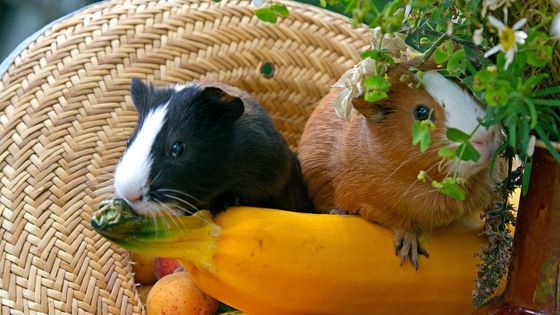In the context of domesticated pets, the term ‘small animals’ usually refers to bunny rabbits, hamsters, ferrets (although these are illegal in several states) and guinea pigs, with the latter perhaps being the most misunderstood.
So, whether you are interested in keeping guinea pigs or else already share your home with a bonded pair and want to check that you are looking after them correctly, here is a comprehensive guide to keeping guinea pigs.
Food & Water
Just like bunny rabbits, by far the most important source of sustenance for guinea pigs is hay, specifically grass hay. Guinea pigs’ teeth are always growing, and grass hays are perfect for filing down their teeth. In addition to grass hay, you should also always provide numerous sources of fresh water, as well as leafy greens such as dandelion greens, mustard greens and kale. As a treat, your guinea pigs will absolutely love a piece of pear, apple or sweet pepper, but always remember this should be in moderation only.
Thankfully, there is a wealth of information on the internet and in relevant books which provide a beginner’s step-by-step guide to looking after guinea pigs, but the best resource of all is a reputable and established vet, such as vets in trail crossing UT.
Handling Your Guinea Pigs
Guinea pigs are prey animals and as a result, it is essential to ensure you have provided more than one safe space for them to burrow and hide in, as and when they desire. This is also why you must always have a pair of guinea pigs, as (just like rabbits) a solo guinea pig is a lonely one.
Once you have got your guinea pigs used to your scent and the presence of your hand near the entrance of the cage, you should have no problem in touching, stroking and slowly scooping up your guinea pig into your hands. Always use two hands for safety and ensure they trust you before you even attempt to handle them.
Housing
The house you choose for your guinea pigs is incredibly important, and remember that when you are not playing with your pigs they should have physical and emotional stimulation. This is essential for their health.
Never choose a house with wire flooring, not only is this extremely uncomfortable for your guinea pigs to walk on, but it also puts them at risk of breaking their legs or otherwise hurting themselves. Instead, choose a solid floor and bedding which is non-toxic, dust-free, highly absorbent and clean and that you regularly clean out the entire house to keep it a comfortable and happy place for your new furry friends.
Additionally, the larger the house, the better and at an absolute minimum, the enclosure should be at least 200 square inches and that the sides of their house are at least 20 inches high. Make sure that the cage is away from any loud noises and out of the way of direct sunlight, with plenty of fresh air and ventilation but not too cold.

